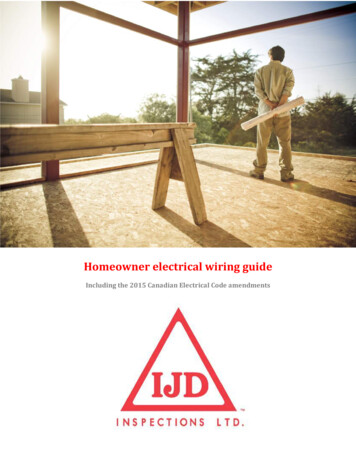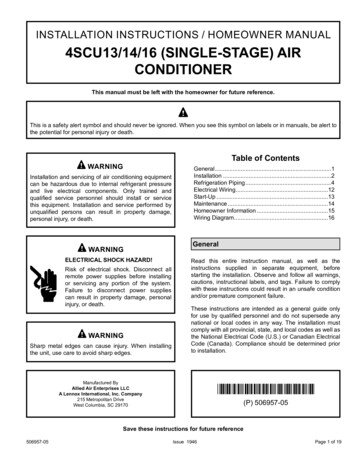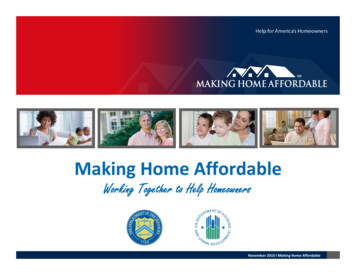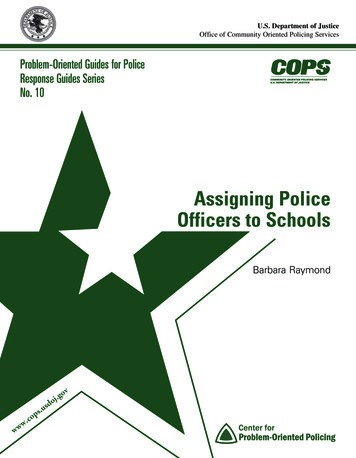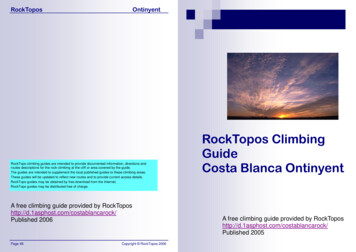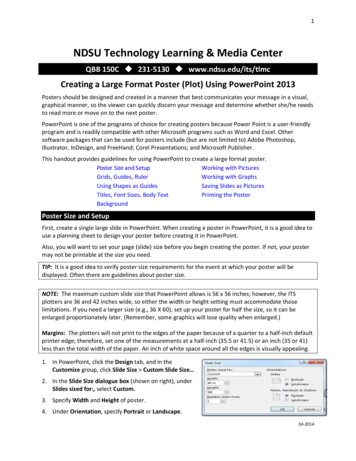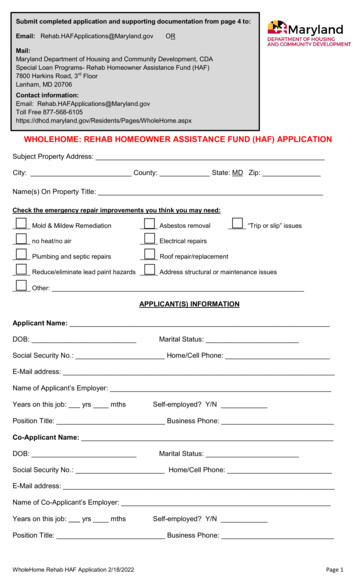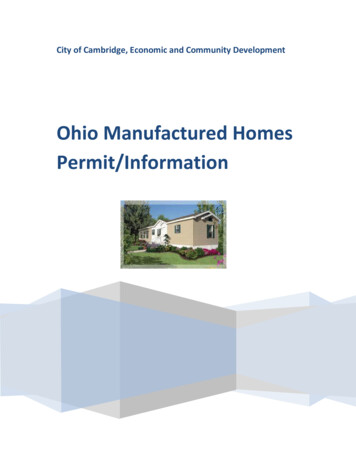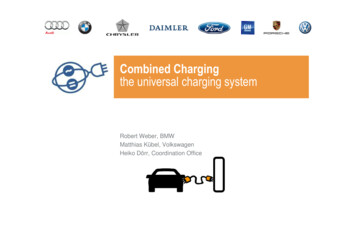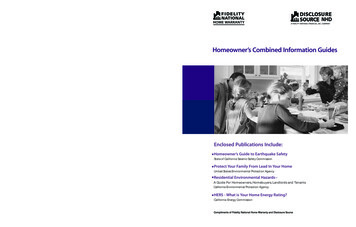
Transcription
Homeowner’s Combined Information GuidesTel: 1-800-TOCOVER (800-862-6837)Fax: 1-800-308-1460www.homewarranty.comTel: 1-800-880-9123Fax: 1-800-287-8673www.disclosuresource.comEnclosed Publications Include:Homeowner’s Guide to Earthquake SafetyState of California Seismic Safety CommissionProtect Your Family From Lead In Your HomeUnited States Environmental Protection AgencyResidential Environmental Hazards A Guide For Homeowners, Homebuyers, Landlords and TenantsCalifornia Environmental Protection AgencyHERS - What is Your Home Energy Rating?California Energy CommissionCompliments of Fidelity National Home Warranty and Disclosure Source
Published by the California Seismic Safety CommissionHomeowner’s Guideto Earthquake Safety2020 EDITIONState of CaliforniaGavin NewsomGovernorSSC No. 20-01
The Homeowner’s Guide to Earthquake Safetywas developed and published by the CaliforniaSeismic Safety Commission. It is distributedunder the provisions of the Library DistributionAct and Government Code Section 11096.*Copyright 2020 by the California Seismic Safety Commission.All rights reserved.LegislationThis guide has been developed and adopted by theCalifornia Seismic Safety Commission as required byAssembly Bill 2959, authored by AssemblymemberJohan Klehs (Chapter 1499, Statutes of 1990), and byAssembly Bill 200, authored by AssemblymemberDominic Cortese (Chapter 699, Statutes of 1991).Ordering InformationSingle copies of this booklet are available from theCalifornia Seismic Safety Commission2945 Ramco St. #195West Sacramento, CA 95691To order call (916) 263-5506 or download an online copy athttp://ssc.ca.gov/forms pubs/index.htmlCover photo: Collapsed two-story home. Nigel Spiers, 2011Shutterstock, Enhanced License*Disclaimer: The effects, descriptions, recommendations and suggestions included inthis Guide are intended to improve earthquake preparedness; however, they do notguarantee the safety of an individual or a structure. The California Seismic SafetyCommission takes responsibility for the inclusion of material in this Guide. The Stateof California, the California Seismic Safety Commission, and all contributors to thisdocument do not assume liability for any injury, death, property damage, loss ofrevenue, or any other effects of earthquakes.Effective July 1, 2020, the 2020 edition of the Homeowner’s Guideto Earthquake Safety replaces the 2005 edition.
California Seismic Safety CommissionIntroductionUSING THIS GUIDEPAGESelling or Buying a Home . 4Earthquake Hazards inCalifornia . 6Residential Earthquake Risks &the Disclosure Statement . 12Tips for a SuccessfulRetrofit . 26EARTHQUAKES AREINEVITABLE IN CALIFORNIA.They can occur at any time and without warning.They can be extremely destructive and even deadly.As a current or future owner of a home*, youshould be aware of the risks—potentiallyconsiderable and catastrophic—that earthquakespose to your property and to the safety of youand your family.Earthquake Safety Tips . 30Other Information . 34THIS GUIDE is designed to help you prevent injuries, savelives, and avoid costly property damage from earthquakes.It provides information on: The most common earthquake-related hazards thatcan damage homes55 How to find and then fix the potential structural risksin a home BILLION12 BILLIONEarthquakerelated lossesin Californiasince 1971Estimated homedamage in the1994 NorthridgeEarthquake How to find more information on earthquake safetyIf you sell your home, this Guide also will help you meetyour requirements under California law.There are no guarantees of safety during earthquakes,but properly constructed and strengthened homes are farless likely to collapse or be damaged during earthquakes.The California Seismic Safety Commission advises you toact on the suggestions outlined in this Guide and makeyourself, your family, and your home safer.*In this Guide, “home” means single-family residences, duplexes, triplexes, andfour-plexes. Under California law, a seller of a home built before 1960 must fulfillcertain disclosure requirements as part of the sales process (see page 4).PAGE 3
HOMEOWNER’S GUIDE TO EARTHQUAKE SAFETYSelling or BuyingA Home: Requirements& RecommendationsSELLING A HOMEIf you are selling a home built before 1960, California law*requires you to: Properly strap the water heater. Provide buyers with the following documents:o A Residential Earthquake Risk Disclosure Statement(page 13), where you identify known home riskso A Natural Hazard Disclosure Statement, where youindicate if your home is in an Earthquake Fault Zone orSeismic Hazard Zone. Ask your realtor for a copy of thisDisclosure Statement.o A copy of this Guide (Your real estate agent is requiredto give you the Guide.)o Note: If you list your home through a real estate agentor broker, you should have him or her give thedocumentation to the buyer. Note: Keep a copy of all documentation signed by the buyeras evidence that you complied with the requirements.Under the law, you are NOT required to: Remove siding, drywall, or plaster to complete thedisclosure statements. Hire someone to evaluate your home or to complete thedisclosure statements. You may seek the assistance of acertified home inspector or a licensed contractor, architect,or engineer. Fix the risks before you sell your home; on the other hand,making the improvements could increase your home‘s value.*A summary of the relevant California laws related to seismic safety is included at the endof this Guide (page 35).PAGE 4
HOMEOWNER’S GUIDE TO EARTHQUAKE SAFETYBUYING A HOMEBefore you agree to buy a home, you should consider the following: Have a certified home inspector, licensed building contractor,engineer, or architect inspect the home and give an opinion onexisting earthquake risks and the estimated cost to strengthenthe home. Check the location of the home to determine if it is in anAlquist-Priolo Earthquake Fault Zone or an area susceptible tolandslides, liquefaction, or tsunami. A licensed geotechnicalengineer and/or engineering geologist can help you answer thesequestions and check the stability of the land under the home. Negotiate with the seller the cost of any proposed repairs orupgrades. State law does not require either the seller or buyer tostrengthen a home against earthquake risks. However, the cost torepair a home after a damaging earthquake may far exceed thecosts to strengthen the home and reduce the risks.Property Tax ExclusionUnder California law (Revenue and Tax Code, Section 74.5), a homeownercan implement seismic-strengthening measures without a property taxreassessment. To receive the exclusion, you must have the work approvedby the local building department and file a claim form with your countytax assessor.Earthquake InsuranceTypically, residential property insurance does not include earthquakecoverage. A homeowner may purchase a separate earthquake policy.Information on earthquake insurance is on page 37.PAGE 5
HOMEOWNER’S GUIDE TO EARTHQUAKE SAFETYEarthquake HazardsKNOW IF YOUR HOMEIS AT RISKIs your homenear an activeearthquakefault or an areaprone to severeshaking?See the maps onpages 10 & 11.Earthquakes occur in California every day. As a homeowner,you should know if your home is in an area that is more proneto earthquakes or if the geology or soil conditions of yourneighborhood or community present greater risk during anearthquake. The more you know, the better able you are totake appropriate precautions to protect your home and family.Requirements under the law: If you are selling your home orany other type of real estate, no matter its age, you mustdisclose to buyers information about natural hazards that canaffect the property, including flood and fire hazards andearthquake hazards. You report this information on the NaturalHazard Disclosure Statement.The most common earthquake-related natural hazards areground shaking, fault ruptures, landslides, liquefaction, andtsunami. In addition, earthquake damage to a dam can be ahazard to “downstream” homes.PAGE 6
HOMEOWNER’S GUIDE TO EARTHQUAKE SAFETYEarthquake HazardsGROUND SHAKINGGuy Morrow, 2004In California, ground shaking causes 99% of earthquake damage to homes. Homes in areasnear large active faults are more likely to feel severe shaking—and experience damage—than homes in other areas of the state.FAULT RUPTUREA strong earthquake cancause the two sides of afault to suddenly slide byone another. Even arelatively minor fault rupturecan cause foundation andstructural damage requiringexpensive repairs.Pilar Villamor, GNS Science, 2016PAGE 7
HOMEOWNER’S GUIDE TO EARTHQUAKE SAFETYEarthquake HazardsLANDSLIDEEarthquake shaking canbe strong enough to causesoil and rock on a hillsideto slide down the slope.A landslide can rip aparthomes at the top of theslope and also crushhomes at the bottom ofthe slope.Al Seib, Los Angeles Times, 1994LIQUEFACTIONGraeme Beattie, BRANZ, 2011Strong ground shaking can cause liquefaction—excess porewater pressure that reduces the soil’s ability to support structures.Liquefaction can cause structures to tilt or collapse.PAGE 8
HOMEOWNER’S GUIDE TO EARTHQUAKE SAFETYEarthquake HazardsTSUNAMIIs your homeat risk of atsunami?Check with yourCounty’s officeof emergencyservices.National Oceanographic andAtmospheric Administration, 1964California’s coastal areas are prone to damage from tsunami—a series of large oceanwaves caused by an underwater earthquake or landslide. Tsunami waves can travela great distance and cause flooding or wash away structures in low-lying areasalong the shore, in and along harbors, and along the banks of rivers. Tsunamisgenerated by the 1964 Alaskan earthquake (magnitude 9.2) and the 2011 Japanearthquake (magnitude 9.0) caused property damage and loss of life in California.DAM FAILUREIs your homenear a dam?E. V. Leyendecker,United StatesGeological Survey,1971Check with yourCounty’s office ofemergency servicesfor a dam inundationmap, which shows thelocation of majordams and areas thatcould flood in theevent ofa dam failure.A very strong earthquake could damage a dam, resulting insudden and devastating flooding of nearby homes. The 1971San Fernando earthquake damaged the Lower San FernandoDam, which sits less than half-mile above the neighborhoods ofthe San Fernando Valley in southern California. The risk of anaftershock forced the three-day evacuation of residents of an11-square-mile area.BETTER SAFE THAN SORRYIf you live in a low-lying coastal area or an area near a dam (daminundation zone), know where to evacuate to higher ground andbe prepared to evacuate immediately after an earthquake.PAGE 9
HOMEOWNER’S GUIDE TO EARTHQUAKE SAFETYEarthquake Shaking Potentialfor California3 BILLIONPER YEARExpectedlong-termaverageearthquakedamage inCaliforniaThis map shows the relative intensity of ground shaking inCalifornia from anticipated future earthquakes and significantearthquakes that have occurred since the Great 1857magnitude 7.9 Fort Tejon earthquake. Although the greatesthazard is in areas of highest intensity as shown on the map,no region is immune from potential earthquake damage.EARTHQUAKE MAGNITUDEEUREKA, 1980M 5.6–6.5M 6.6–7.0EUREKA, 1954M 7.1–7.9OROVILLE, 1975CAPE MENDOCINO,1992TAHOE, 1966WINTERS/Vacaville, 1892SANTA ROSA, 1969MAMMOTH LAKES, 1980SOUTH NAPA, 2014CHALFANT VALLEY, 1986OWENS VALLEY, 1872SAN FRANCISCO, 1906MORGAN HILL, 1984LOMA PRIETA. 1989RIDGECREST, 2019COALINGA, 1983FORT TEJON, 1857SAN SIMEON, 2003KERN COUNTY, 1952BIG BEAR, 1992HECTOR MINE, 1999LANDERS. 1992PALM SPRINGS,1986Level of Earthquake HazardThese regions are near faults andwill on average experience strongerearthquake shaking more frequently.This intense shaking can damageeven strong, modern buildings.IncreasingIntensityThese regions are distant from knownfaults and will experience lower levelsof shaking less frequently. In mostearthquakes, only weaker, masonrybuildings would be damaged.However, very infrequent earthquakescould still cause strong shaking here.WaterSANTA BARBARA, 1925SAN FERNANDO, 1971NORTHRIDGE, 1994SIERRA MADRE, 1991WHITTIER NARROWS. 1987LONG BEACH, 1933SUPERSTITION HILLS, 1987IMPERIAL VALLEY, 1940IMPERIAL VALLEY, 1979EL MAYOR-CUCAPAH, 2010Source: California Geological Survey Map and U.S. Geological SurveyPAGE 10
HOMEOWNER’S GUIDE TO EARTHQUAKE SAFETYSignificant Historical Earthquakes andTheir ShakeMapsThe ShakeMaps (inserts) show areas of moderate-to-heavy ground shakingin four historical earthquakes.1906 M 7.8 San Francisco1992 M 7.2 Petrolia1989 M 6.9 Loma PrietaEARTHQUAKE MAGNITUDEM 5.6–6.5M 6.6–7.0M 7.1–7.91994 M 6.7 NorthridgeShakeMap ExplanationIII-IIIIVVVIVIIVIIIIXX Source: USGSPAGE 11
IN THIS SECTIONPAGECompleting the ResidentialEarthquake Risk DisclosureStatement . 12-13Identifying and DisclosingEarthquake Risks . 14-25Water Heaters . 14Unbolted Foundations . 15Crawl Space (Cripple) Walls . 17Pier-and-Post Foundations . 18Unreinforced MasonryFoundations . 19Hillside Homes . 20Unreinforced Masonry Walls . 21Rooms over Garages . 22Unreinforced MasonryChimneys . 23Inadequate Foundation . 24Homes withUnique Designs . 25You are not required to removesiding, drywall, or plaster or to hirean inspector to determine theanswer to a question. Also, you arenot required to fix or retrofit yourhome before you sell the property.ResidentialEarthquake Risks & theDisclosure StatementEarthquakes in California can occur at any time and withoutwarning. To prevent injuries and avoid costly propertydamage, homeowners should determine the potential forearthquake risks in their homes and then retrofit or upgradethese conditions. If not corrected, these risks can lead to: Severe property damage, including foundationdamage and damage to floors, walls, and windows Loss of personal property Broken utilities, which can result in fire, water damage,and spread of toxic substances Personal injuriesIn addition, under California law, sellers of homes builtbefore 1960 must disclose known earthquake risks tobuyers as part of the property sales process.Completing the Residential Earthquake RiskDisclosure StatementWhen you sell a home built before 1960, you are required tofill out the Residential Earthquake Risk Disclosure Statement,(see next page) and give the completed statement to thebuyer. You are required to answer each question to the bestof your knowledge.To complete the Disclosure Statement, answer: “Yes” if you know your home is protected from the risk(e.g., for Item #1, answer “Yes” if your home’s waterheater is properly braced) “No” if you know your home is at risk (e.g., for Item #6,answer “No” if your home’s exterior brick walls are notstrengthened) “Doesn’t Apply” if the question is not relevant to yourhome (e.g., for Item #7, answer “Doesn’t Apply” if yourhome does not have a living space over the garage) “Don’t Know” if you do not have adequate informationto answer the questionPAGE 12
HOMEOWNER’S GUIDE TO EARTHQUAKE SAFETYResidential Earthquake Risk Disclosure Statement (2020 Edition)NameAssessor’s Parcel No.Street AddressYear BuiltCityCountyZip CodeAnswer these questions to the best of your knowledge. If any of the questions are answered “No,” your home is likely tohave an elevated/disclosable earthquake risk. If you do not have actual knowledge as to whether these risks exist, answer“Don’t Know.” Questions answered “Don’t Know” may indicate a need for further evaluation. If your home does not havethe feature, answer “Doesn’t Apply.” If you corrected one or more of these risks, describe the work on a separate page.The page numbers in the right-hand column indicate where in this guide you can find information on each of these features.1. Is the water heater braced to resist falling during an earthquake?YesNoDoesn’tApplyDon’tKnowSeePage 14152. Is your home bolted to its foundation?3. If your home has crawl space (cripple) walls:17a. Are the exterior crawl space (cripple) walls braced?b. If the exterior foundation consists of unconnected concrete piers andposts, have they been strengthened? 4. If the exterior foundation, or part of it, is made of unreinforced masonry,has it been strengthened?18195. If your home is on a hillside:a. Are the exterior tall foundation walls braced?20b. Are the tall posts or columns either built to resist earthquakes or havethey been strengthened? 6. If the exterior walls of your home are made of unreinforced masonry,either completely or partially, have they been strengthened?7. If your home has a room over the garage, is the wall around the garage dooropening built to resist earthquakes or has it been strengthened?2021 8. Is your home outside an Alquist-Priolo Earthquake Fault Zone (an areaimmediately surrounding known active earthquake faults)?To be reported on the NaturalHazard Disclosure Statement9. Is your home outside a Seismic Hazard Zone (an area identified as susceptibleto liquefaction or a landslide)?To be reported on the NaturalHazard Disclosure Statement22As seller of the property described herein, I have answered the questions above to the best of my knowledgein an effort to disclose fully any potential earthquake risks it may have.EXECUTED BYSellerSellerDateI acknowledge receipt of the Homeowner’s Guide to Earthquake Safety and this Disclosure Statement, completed andsigned by the seller. I understand that if the seller has answered “No” to one or more questions, or if the seller hasindicated a lack of knowledge, there may be one or more earthquake risks in this home.BuyerBuyerDateThis Disclosure Statement is made in addition to the standard real estate transfer disclosure statement alsorequired by law.PAGE 13
HOMEOWNER’S GUIDE TO EARTHQUAKE SAFETYEarthquake Risk Disclosure Statement Item 1Is your home’s water heaterbraced?If your home’s water heater is not properly braced, or if it hasrigid rather than flexible pipes, the water heater may moveor topple during an earthquake. This movement can break gasor water lines, resulting in fire, water damage, or release oftoxic gas.Under California law, you are required to brace your home’swater heater whenever you install a new water heater or if yousell the home.How to Check for Proper Water Heater BracingDuring an earthquake,an unbraced waterheater can topple,which can start a fireor lead to major waterdamage.1. Examine your home’s water heater.2. Look for two sets of straps that wrap around the waterheater and securely bolt the water heater to the wall andwall studs (see diagram).Tankless Water Heater?If you have a tankless water heater, be sure it is securely attachedto the wall and that its pipes are installed according to themanufacturer’s instructions.PROPER WATER HEATER BRACINGSheetrockWANT TO RETROFIT?Find out more on pages 26-29.PAGE 14
HOMEOWNER’S GUIDE TO EARTHQUAKE SAFETYEarthquake Risk Disclosure Statement Item 2Is your home bolted to its foundation?If your home is not bolted to its foundation, it could slide off the foundationduring an earthquake. A home that has moved can cause gas, water, and sewer lines tobreak, resulting in fire, water damage, and release of toxic fluids. Lifting a home back onto its foundation is difficult and expensive.How to Check for Foundation Bolting1. Determine if your home has a crawl space, which will be below thefirst floor.Clue: If your home has steps leading to an exterior door, the homeprobably has a crawl space. If you have no steps, the home is most likelybuilt on a concrete slab and has no crawl space. If you do not have acrawl space, see “What If”section on next page.2. Go into the crawl space. Access will be through a small removable panelor door along an exterior wall or from inside the garage.3. Look for areas of unfinished wood framing at base of walls (see diagram).If the crawl space has finished wood framing, see “What If”section.4. Find sill plates (wood boards that sit directly on top of foundation) andlook for anchor bolts that fasten sill plates to foundation (see diagram onnext page). Adequate bolting: Bolts with nuts and square washers spaced every4 to 6 feet Inadequate bolting: No visible boltsWANT TO RETROFIT?Find out more on pages 26-29.PAGE 15
HOMEOWNER’S GUIDE TO EARTHQUAKE SAFETYWHAT IF . . .Q My home does not have a crawl space?A Particularly after 1960, many California homes were builtdirectly on concrete slabs. Fortunately, most of these homesand other post-1960 homes built to code have anchor bolts.Q The crawl space has finished framing, so I cannot see thesill plates or anchors?A You are not required to remove siding, drywall or plaster todetermine if your home’s foundation has anchor bolts.For both situations, check “Don’t Know” on the Disclosure Statement.LOCATING FOUNDATION BOLTSWANT TO RETROFIT?Find out more on pages 26-29.PAGE 16
HOMEOWNER’S GUIDE TO EARTHQUAKE SAFETYEarthquake Risk Disclosure Statement Item 3aAre your crawl space(cripple) walls braced?If your home has a crawl space with un-braced walls,these crawl space (cripple) walls could collapse during anearthquake, which, in turn, may cause your entire hometo collapse or lead to major damage to the structure aswell as possible fire, water line breaks and injuries.How to Check for Bracing of Crawl Space Walls1. Determine if your home has a crawl space with cripple walls.Clue: If your home has three or more steps leading to an exterior door,the home has a crawl space below the first floor and, therefore, hascripple walls.2. Go into the crawl space. Access will be through small removable panel ordoor along an exterior wall or from inside the garage.This older homecollapsed afterearthquakeshakingdamaged itscrawl space(cripple) walls.3. Examine the inside surfaces of the exterior walls. Adequate bracing: Plywood or diagonal sheathing on exterior walls(see diagrams) Inadequate bracing: No plywood or diagonal sheathingPLYWOOD OR ORIENTEDSTRAND BOARDDIAGONAL SHEATHINGWANT TO RETROFIT?Find out more on pages 26-29.PAGE 17
HOMEOWNER’S GUIDE TO EARTHQUAKE SAFETYEarthquake Risk Disclosure Statement Item 3bIs your home’s pier-and-postfoundation strengthened?If your home sits on large wood posts that rest onunconnected concrete piers, the posts may not be bracedproperly. During an earthquake, the posts could fail andyour home could shift or collapse.This home’s pier-and-postfoundation was damagedduring an earthquake.The diagonal bracing wasadded after the earthquaketo temporarily stabilize thehome during repairs.How to Check for Pier-and-Post Foundation Strengthening1. Go under the home and determine the type of foundationthat supports the exterior walls. Continuous perimeter foundation wall (check “Does NotApply” on the statement) Concrete piers and wood posts2. For concrete piers and wood posts, look further to determineif the foundation is adequately braced or strengthened. Adequate bracing: A continuous foundation around theperimeter edges of the home that consists of eitherreinforced concrete or reinforced masonry. Inadequate bracing along the perimeter edges of the home:oWood posts supported by concrete piers, oroWood posts without concrete piers or continuousperimeter foundationsWANT TO RETROFIT?Find out more on pages 26-29.PAGE 18
HOMEOWNER’S GUIDE TO EARTHQUAKE SAFETYEarthquake Risk Disclosure Statement Item 4Is your home’s unreinforcedmasonry foundationstrengthened?If your home is supported by a brick, stone or concrete blockfoundation that lacks steel reinforcing, the foundation maynot be able to resist earthquake shaking. Your home couldslide off its foundation during an earthquake, damaging the walls andfloors, rupturing utility connections, and destroying the contents ofyour home. This, in turn, could lead to fire, water damage, and injuries.How to Check an Unreinforced Masonry Foundation1. Walk around the perimeter of your home to determine the composition ofthe foundation. If the foundation has siding or a plaster finish, you will needto check the foundation from inside the crawl space. Solid concrete foundation (check “Does Not Apply” on the statement) Unreinforced brick, stone, or concrete block foundation2. For unreinforced brick, stone, or concrete block foundation, look furtherto determine if the foundation is adequately braced or strengthened(e.g., steel plates attached to foundation walls). If you do not know whatto look for, consult a licensed engineer or architect.WANT TO RETROFIT?Find out more on pages 26-29.PAGE 19
HOMEOWNER’S GUIDE TO EARTHQUAKE SAFETYEarthquake Risk Disclosure Statement Item 5Does the foundation ofyour hillside home haveadequate support?Hillside homes require special engineering to resistearthquake shaking.If your home is built on a hillside and the home’s tall foundationwalls and stilt-type support posts are not properly braced, yourhome could collapse during an earthquake, causing severedamage to the home and injuries.How to Check the Foundation of a Hillside HomeThe balcony of thishillside home partiallycollapsed and the hometilted when thestilt-type support postsand poorly braced wallsshifted during anearthquake.1. Walk around the perimeter of your home to examine both thetall foundation walls and the tall posts or columns that supportthe home.2. Examine the exterior tall foundation walls for evidence ofextensive wall bracing below the home.3. If you do not know what to look for, consult a licensed engineeror architect.WANT TO RETROFIT?Find out more on pages 26-29.PAGE 20
HOMEOWNER’S GUIDE TO EARTHQUAKE SAFETYEarthquake Risk Disclosure Statement Item 6Are your home’s unreinforcedmasonry walls strengthened?If your home has walls built of unreinforced masonry—brick, hollow clay tiles, stone, concrete blocks, oradobe—the walls may be too brittle to resist earthquakeshaking. As a result, the walls could collapse in anearthquake.How to Check for Unreinforced Masonry Walls1. Walk around the perimeter of your home to examine the composition ofthe exterior walls. Look for evidence of unreinforced brick, clay tile, stone,adobe, or concrete-block wall construction. Look closely at wall surfaces at windows and doors. If the exterior walls are covered with plaster, examine the walls frominside the home (e.g., beneath light switch plates).2. If the exterior walls are built of masonry, check further for the strength ofconstruction or for indicators of retrofit. Steel plates and anchor bolts arecommon retrofits (see photo).3. If you do not know what to look for, consult a licensed engineeror architect.A steel plate with anchor bolts.WANT TO RETROFIT?Find out more on pages 26-29.PAGE 21
HOMEOWNER’S GUIDE TO EARTHQUAKE SAFETYEarthquake Risk Disclosure Statement Item 7Does your home have aroom above the garage?If your home has a room above the garage, you need to ensurethat the narrow walls on either side of the garage doorway arestrong enough to withstand earthquake shaking. Withoutadequate support, these walls could collapse, causing seriousdamage and injuries.How to Check the Strength of a Garage with a Room AboveThe walls around thegarage door of this homewere not strong enoughto withstand the shakingof the 1989 Loma PrietaEarthquake.1. Go into your garage and examine the walls on both sidesof the garage doorway. If the garage has been built orstrengthened to support a second story, you will see plywoodbracing on the walls and metal straps (see diagram).2. If you do not know what to look for, consult a licensedengineer or architect.GARAGE WALL BRACINGAdequate bracing for a garage wall includesplywood and metal straps.WANT TO RETROFIT?Find out more on pages 26-29.PAGE 22
HOMEOWNER’S GUIDE TO EARTHQUAKE SAFETYOther Structural RisksYour home also may have other structural issues that could result in seriousproperty damage or injuries during an earthquake. These risks are not includedin the Residential Earthquake Risk Disclosure Statement because, typically, it isnot cost effective to complete a retrofit. On the other hand, these risks shouldbe considered if you are a homeowner or a potential home buyer.UNREINFORCED MASONRY CHIMNEYIf your home has an unreinforced brick or stone chimney, it couldcollapse during an earthquake and fall on the ground beside thehome or fall through the roof into your home (see photos).How to Check Your ChimneyTo determine if your chimney will withstand an earthquake:1. Check the mortar with a screwdriver. If the mortar crumbles,it may be too weak to withstand earthquake shaking.2. Access the attic area above the fireplace to verify that thechimney is securely attached to the home with metal strapsor ties.California EarthquakeAuthority, 20143. If you are unable to verify the strength of the chimney, consulta licensed engineer or architect or a general contractor.How to Protect against Damage and Injuries(Safety Precautions) Avoid parking cars or locating patios or children’s play areaswithin the falling radius of a chimney. Remind home occupants to stay away from chimneys andfireplaces during earthquakes.Bay Area RegionalEarthquakePreparednessProject, 1989WANT TO RETROFIT?Find out more on pages 26-29.PAGE 23
HOMEOWNER’S GUIDE TO EARTHQUAKE SAFETYOther Structural RisksINADEQUATE FOUNDATIONA wood foundation or a foundation of concrete or masonry thatis cracked or crumbling may not have the strength to withstandearthquake shaking.How to Check the Condition of Your FoundationDetermining if a foundation is susceptible to earthquake damagecan be a challenge, and the advice of a licensed engineer orarchitect or a foundation contractor may be necessary.Wood foundation: In the past, some homes were built onwood beams laid directly on the ground without concrete ormasonry su
strengthen a home against earthquake risks. However, the cost to repair a home after a damaging earthquake may far exceed the costs to strengthen the home and reduce the risks. Property Tax Exclusion . Under California law (Revenue and Tax Code, Section 74.5), a homeowner can implement seismic-strengthening measures without a property tax

